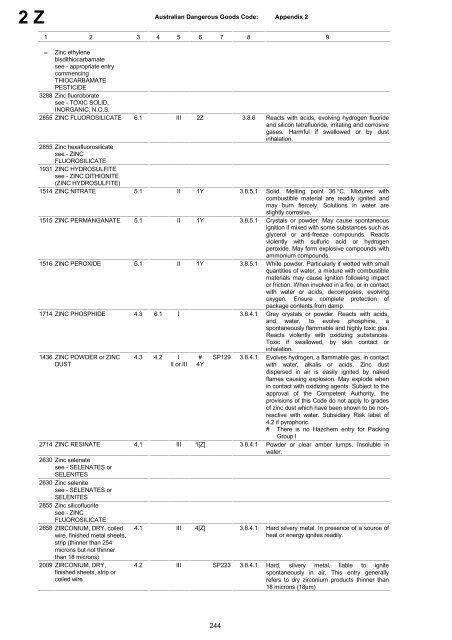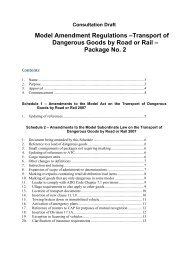Australian Code for the Transport of Dangerous Goods - National ...
Australian Code for the Transport of Dangerous Goods - National ...
Australian Code for the Transport of Dangerous Goods - National ...
Create successful ePaper yourself
Turn your PDF publications into a flip-book with our unique Google optimized e-Paper software.
2 Z<br />
<strong>Australian</strong> <strong>Dangerous</strong> <strong>Goods</strong> <strong>Code</strong>: Appendix 2<br />
1 2 3 4 5 6 7 8 9<br />
– Zinc ethylene<br />
bisdithiocarbamate<br />
see - appropriate entry<br />
commencing<br />
THIOCARBAMATE<br />
PESTICIDE<br />
3288 Zinc fluoroborate<br />
see - TOXIC SOLID,<br />
INORGANIC, N.O.S.<br />
2855 ZINC FLUOROSILICATE<br />
2855 Zinc hexafluorosilicate<br />
see - ZINC<br />
FLUOROSILICATE<br />
1931 ZINC HYDROSULFITE<br />
see - ZINC DITHIONITE<br />
(ZINC HYDROSULFITE)<br />
6.1 III 2Z 3.8.6 Reacts with acids, evolving hydrogen fluoride<br />
and silicon tetrafluoride, irritating and corrosive<br />
gases. Harmful if swallowed or by dust<br />
inhalation.<br />
1514 ZINC NITRATE 5.1 II 1Y 3.8.5.1 Solid. Melting point 36 °C. Mixtures with<br />
combustible material are readily ignited and<br />
may burn fiercely. Solutions in water are<br />
slightly corrosive.<br />
1515 ZINC PERMANGANATE 5.1 II 1Y 3.8.5.1 Crystals or powder. May cause spontaneous<br />
ignition if mixed with some substances such as<br />
glycerol or anti-freeze compounds. Reacts<br />
violently with sulfuric acid or hydrogen<br />
1516 ZINC PEROXIDE 5.1 II 1Y 3.8.5.1<br />
peroxide. May <strong>for</strong>m explosive compounds with<br />
ammonium compounds.<br />
White powder. Particularly if wetted with small<br />
quantities <strong>of</strong> water, a mixture with combustible<br />
materials may cause ignition following impact<br />
or friction. When involved in a fire, or in contact<br />
with water or acids, decomposes, evolving<br />
oxygen. Ensure complete protection <strong>of</strong><br />
1714 ZINC PHOSPHIDE 4.3 6.1 I 3.8.4.1<br />
package contents from damp.<br />
Grey crystals or powder. Reacts with acids,<br />
and water, to evolve phosphine, a<br />
spontaneously flammable and highly toxic gas.<br />
Reacts violently with oxidizing substances.<br />
Toxic if swallowed, by skin contact or<br />
inhalation.<br />
1436 ZINC POWDER or ZINC<br />
DUST<br />
4.3 4.2 I<br />
II or III<br />
#<br />
4Y<br />
SP129 3.8.4.1 Evolves hydrogen, a flammable gas, in contact<br />
with water, alkalis or acids. Zinc dust<br />
dispersed in air is easily ignited by naked<br />
flames causing explosion. May explode when<br />
in contact with oxidizing agents. Subject to <strong>the</strong><br />
approval <strong>of</strong> <strong>the</strong> Competent Authority, <strong>the</strong><br />
provisions <strong>of</strong> this <strong>Code</strong> do not apply to grades<br />
<strong>of</strong> zinc dust which have been shown to be nonreactive<br />
with water. Subsidiary Risk label <strong>of</strong><br />
4.2 if pyrophoric.<br />
# There is no Hazchem entry <strong>for</strong> Packing<br />
Group I<br />
2714 ZINC RESINATE 4.1 III 1[Z] 3.8.4.1 Powder or clear amber lumps. Insoluble in<br />
water.<br />
2630 Zinc selenate<br />
see - SELENATES or<br />
SELENITES<br />
2630 Zinc selenite<br />
see - SELENATES or<br />
SELENITES<br />
2855 Zinc silic<strong>of</strong>luorite<br />
see - ZINC<br />
FLUOROSILICATE<br />
2858 ZIRCONIUM, DRY, coiled<br />
wire, finished metal sheets,<br />
strip (thinner than 254<br />
microns but not thinner<br />
than 18 microns)<br />
2009 ZIRCONIUM, DRY,<br />
finished sheets, strip or<br />
coiled wire<br />
4.1 III 4[Z] 3.8.4.1 Hard silvery metal. In presence <strong>of</strong> a source <strong>of</strong><br />
heat or energy ignites readily.<br />
4.2 III SP223 3.8.4.1 Hard, silvery metal, liable to ignite<br />
spontaneously in air. This entry generally<br />
refers to dry zirconium products thinner than<br />
18 microns (18μm)<br />
244






